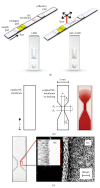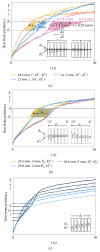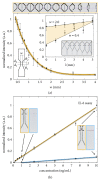Geometric Flow Control Lateral Flow Immunoassay Devices (GFC-LFIDs): A New Dimension to Enhance Analytical Performance
- PMID: 31549085
- PMCID: PMC6750055
- DOI: 10.34133/2019/8079561
Geometric Flow Control Lateral Flow Immunoassay Devices (GFC-LFIDs): A New Dimension to Enhance Analytical Performance
Abstract
The nitrocellulose (NC) membrane based lateral flow immunoassay device (LFID) is one of the most important and widely used biosensor platforms for point-of-care (PoC) diagnostics. However, the analytical performance of LFID has limitations and its optimization is restricted to the bioassay chemistry, the membrane porosity, and the choice of biolabel system. These bottom neck technical issues resulted from the fact that the conventional LFID design principle has not evolved for many years, which limited the LFID for advanced biosensor applications. Here we introduce a new dimension for LFID design and optimization based on geometric flow control (GFC) of NC membranes, leading to highly sensitive GFC-LFID. This novel approach enables comprehensive flow control via different membrane geometric features such as the width (w) and the length (l) of a constriction, as well as its input angle (θ 1) and output angle (θ 2). The GFC-LFID (w=0.5 mm, l=7 mm, θ 1 = 60°, θ 2 = 45°) attained a 10-fold increase in sensitivity for detection of interleukin-6 (IL-6), compared with conventional LFID, whereas reducing by 10-fold the antibody consumption. The GFC-LFID detects IL-6 over a linear range of 0.1-10 ng/mL with a limit of detection (LoD) of 29 pg/mL, which even outperforms some commercial IL-6 LFIDs. Such significant improvement is attained by pure geometric control of the NC membrane, without additives, that only relaying on a simple high throughput laser ablation procedure suitable for integration on regular large-scale manufacturing of GFC-LFIDs. Our new development on GFC-LFID with the combination of facile scalable fabrication process, tailored flow control, improved analytical performance, and reduced antibodies consumption is likely to have a significant impact on new design concept for the LFID industry.
Conflict of interest statement
The authors declare that there are no conflicts of interest regarding the publication of this article.
Figures




Similar articles
-
Optimization of flow path parameters for enhanced sensitivity lateral flow devices.Talanta. 2022 Oct 1;248:123579. doi: 10.1016/j.talanta.2022.123579. Epub 2022 May 25. Talanta. 2022. PMID: 35660999
-
A nitrocellulose/cotton fiber hybrid composite membrane for paper-based biosensor.Cellulose (Lond). 2023 Jun 3:1-13. doi: 10.1007/s10570-023-05288-4. Online ahead of print. Cellulose (Lond). 2023. PMID: 37360890 Free PMC article.
-
A paper microfluidics-based fluorescent lateral flow immunoassay for point-of-care diagnostics of non-communicable diseases.Analyst. 2019 Nov 7;144(21):6291-6303. doi: 10.1039/c9an01382b. Epub 2019 Sep 24. Analyst. 2019. PMID: 31549693
-
Advances in paper-based point-of-care diagnostics.Biosens Bioelectron. 2014 Apr 15;54:585-97. doi: 10.1016/j.bios.2013.10.075. Epub 2013 Nov 19. Biosens Bioelectron. 2014. PMID: 24333570 Review.
-
Novel strategies to enhance lateral flow immunoassay sensitivity for detecting foodborne pathogens.J Agric Food Chem. 2015 Jan 28;63(3):745-53. doi: 10.1021/jf5046415. Epub 2015 Jan 13. J Agric Food Chem. 2015. PMID: 25539027 Review.
Cited by
-
Paper-Based Biosensors for COVID-19: A Review of Innovative Tools for Controlling the Pandemic.ACS Omega. 2021 Oct 29;6(44):29268-29290. doi: 10.1021/acsomega.1c04012. eCollection 2021 Nov 9. ACS Omega. 2021. PMID: 34778604 Free PMC article. Review.
-
Point-of-care detection of cytokines in cytokine storm management and beyond: Significance and challenges.View (Beijing). 2021 Aug;2(4):20210003. doi: 10.1002/VIW.20210003. Epub 2021 May 4. View (Beijing). 2021. PMID: 34766163 Free PMC article. Review.
-
Fabrication, Flow Control, and Applications of Microfluidic Paper-Based Analytical Devices.Molecules. 2019 Aug 7;24(16):2869. doi: 10.3390/molecules24162869. Molecules. 2019. PMID: 31394856 Free PMC article. Review.
-
An update on lateral flow immunoassay for the rapid detection of SARS-CoV-2 antibodies.AIMS Microbiol. 2023 Apr 13;9(2):375-401. doi: 10.3934/microbiol.2023020. eCollection 2023. AIMS Microbiol. 2023. PMID: 37091823 Free PMC article. Review.
-
Unraveling the Hook Effect: A Comprehensive Study of High Antigen Concentration Effects in Sandwich Lateral Flow Immunoassays.Anal Chem. 2020 Dec 1;92(23):15587-15595. doi: 10.1021/acs.analchem.0c03740. Epub 2020 Nov 13. Anal Chem. 2020. PMID: 33185097 Free PMC article.
References
LinkOut - more resources
Full Text Sources
Other Literature Sources

